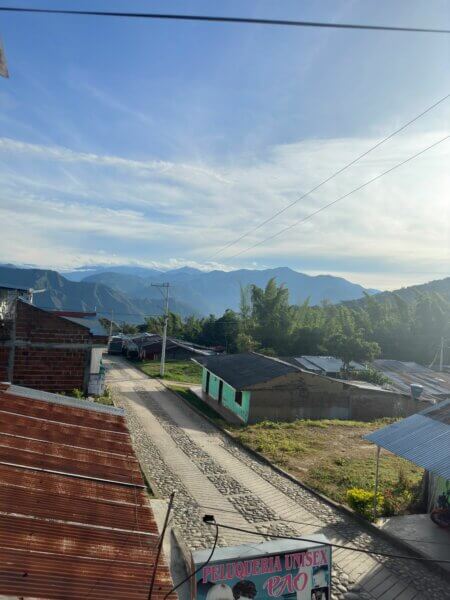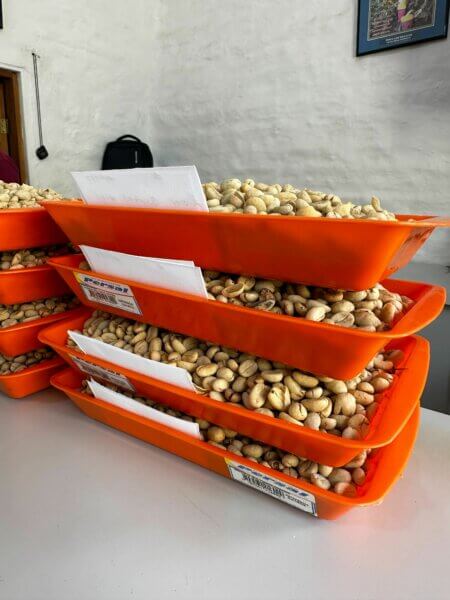Inzá harvest is in full swing. After weeks on the ground cupping coffee, talking to producers, and making commitments, we’re getting ready to ship a stellar slate of coffees out of the Inzá subregion of Cauca.
Despite ongoing climate and cost challenges, the coffees we’re bringing in are essential Inzá. They have brilliant sweetness and red fruit character underpinning a strong, well-structured acidity like lemon peel, lime, and tangerine, a delicate yet notable florality like apple blossom, an approachable suite of sugar-browning notes from caramel and brown sugar, and a cinnamon/cardamom aromatic we look forward to every fall and winter.

Strengthening supply chains: microclimate, lot construction, logistics, & pricing
Inzá is unique in its microclimate: deeper into Colombia’s mountainous jungle regions, than Nariño, Inzá is a cooler area. This, combined with the intensity of Inzá’s rains, slows drying to an average of 2 weeks. Slower drying enhances and clarifies the flavors of these coffees, which, as described above, offer everything you could want from a Colombian coffee. Populated by indigenous smallholders with 1-3 hectares, Inzá not only has the microclimates, but also the elevation: farms here are almost entirely located at an altitude between 1500-2000 masl.
Reaching Inzá usually takes around 9 hours by road from Popayán. Once we arrive at Inzá we go directly to Pedregal to cup a wide range of coffee from the local community and select the Colombian jewels of 2023.
Because our producer partners work in such small plots, it’s hours and hours cupping each one and making careful decisions about when to separate a single producer and when to build community lots. Community lots are bespoke, carefully constructed to reflect hyperlocal flavor profiles.
From there, we prioritize logistics, making sure the product that arrives in the states is equal to the one that left origin, and in fact has a chance to continue opening up after arrival.
We’ve been working in this area with these communities since 2007, when the remoteness of the region meant a lack of market access. Now, producers here have options for where they sell their coffee, and we continue to pay premium rates so that the relationships feel mutually rewarding.

Challenges past & present
Visiting Colombia is always exciting but never without a unique set of challenges. This year, issues in Inzá are very similar to those in Nariño, but even worse in certain cases regarding flooding.
Last year, there was a global price rise that led producers to rush harvest and processing, with many losing quality focus in the sprint for ultra-high prices. This year, prices are 56% lower and most producers have refocused on optimizing quality, which is great to see. But, there have been other challenges this year has brought specifically.
- Climate: June and July brought torrential rains causing landslides, flooding in the areas near rivers, and road obstruction—in Inzá, they were totally cut off for an entire month when the only access road was destroyed. Now they’re dealing with the opposite: severe drought and massive forest fires that are devastating various coffee-growing areas, spreading faster in the August winds.
- Economic: The rise in prices of everyday products, such as rice, noodles, and others remains a constant pressure point. Farm inputs are no exception.
- Policy: Given that Colombia is a purely coffee-producing country, the government had provided annual national subsidies for the purchase of fertilizers, which greatly helped producers. This year, the current government—despite having declared that they were going to continue providing this support—has not done so. Several producers have told us that in 2023 they have received zero subsidy, forcing many to significantly reduce fertilizer usage. This, added to the severe drought, is resulting in general stress for the plants.
Despite these stressors, the coffees we’re bringing in are the quailty we’ve come to expect from this unique producing community.

The Journey
Inzá is part of the Cauca department, but it’s so close to the Huila border that in a lot of ways these coffees have more in common with a typical Huila profile than the typical Cauca profile: hence why we call them Inzá and give them their own credit. The primary city where we cup coffees here is Pedregal, a very small town whose community is primarily dedicated to growing coffee and producing food for local sale.
Pedregal is very remote. A very calm and quiet place without mobile signal, it forces you to disconnect and be present with the space around you. During the weekend, farmers come down to sell their products and buy groceries for their families before heading back to their farms for the week.
Getting into Inzá takes a while. Coming in through Huila, you can head through Bogotá to the Benito Salas Neiva Huila airport. From there you can take public transport for 4 hours to La Plata Huila and continue on the La Plata-Inza road, which takes you to Popayán.
From Popayán you continue by public transport for 3 hours, crossing the Páramo del Purace, a protected forest key for its abundant vegetation and biodiverse flora and fauna. In the middle of the journey you’ll also see some small coffee-producing farms. After 3 hours, you’ll see a small collection of indigenous populations that make up Inzá, with archaeological preserves and mountains that look like pyramids.
Arriving at the town of Inzá, you’ll have to take another means of transportation for another hour to get to Pedregal. On the way, you’ll see tiny coffee farms surrounded by immense mountains and rivers that make the panorama magical and absolutely unique.
| Interested in sourcing coffee with us? Reach out at info@redfoxcoffeemerchants.com. To learn more about our work, check out our journal and follow us on Instagram @redfoxcoffeemerchants, Twitter @redfoxcoffee, Spotify, and YouTube.
|
